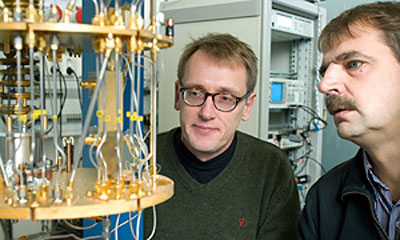| Nov 08, 2011 |
Millions in research to take graphene out of the lab
|
|
(Nanowerk News) Graphene can enable the best quantum resistance standard. This is one of many advances emerging from the active research into graphene at Chalmers University of Technology. Chalmers will now receive the lion's share of a new Swedish research grant of SEK 40 million for the supermaterial graphene.
|
|
Following the new financing from the Knut and Alice Wallenberg Foundation, a group of some 30 Swedish graphene researchers will be formed, in a close collaboration between Chalmers and the universities of Uppsala and Linköping. The effort will form the Swedish spearhead in international graphene research – a hot topic ever since the Nobel Physics Prize in 2010.
|
|
"We are now achieving critical mass, and will benefit from valuable cross-fertilization between several research areas, all of which are involved in graphene," says Mikael Fogelström, the project coordinator. "The money will be used for everything from producing graphene to developing a variety of products, with basic research into experimental and theoretical physics along the way."
|
 |
| Mikael Fogelström and Sergey Kubatkin are two of the Chalmers researchers investigating the supermaterial graphene. The cryostat in the picture is used to cool graphene samples to one hundredth of a degree above absolute zero.
|
|
The graphene production process needs to be improved and made more reproducible. The researchers will develop reliable synthesis methods designed to produce high-quality graphene surfaces. Following that, the material will be investigated and processed at the nano level, ultimately to be used for specific components with far better performance than today's electronic devices.
|
|
The Chalmers researchers have already achieved several important breakthroughs with graphene, despite the fact that the material was first produced as recently as 2004. One example is a new standard for the quantum of resistance – a "tuning fork" for calibrating the correct resistance in electrical instruments and devices. State-of-the-art resistance standards are based on silicon or gallium arsenide. These are difficult to manufacture, and the method only works at extremely low temperatures and in large magnetic fields. A new generation of resistance standards based on graphene are at least as accurate as those in use today, while benefitting from being substantially easier to produce and use.
|
|
In another project, Chalmers researchers have produced a graphene transistor that operates at more than 10 gigahertz. They are now working on producing one capable of reaching into the terahertz range – in other words faster than 100 gigahertz. This may become possible thanks to a large grant that Mikael Fogelström's research group received earlier this year from the Foundation for Strategic Research – SEK 28.5 million over a five-year period.
|
|
"Graphene has enormous potential in high-frequency electronics, and Chalmers is at the forefront of this research," Mikael Fogelström says. "This material can open up a whole world of new possibilities. One example is "see-through cameras" that can see through clothes at security checkpoints. We are also hoping to find new applications unique to graphene in areas other than high-frequency electronics."
|
|
Now that graphene research at Chalmers has stable financing for five years, the researchers are thinking of setting up a centre for graphene.
|
|
"It would be a good idea to get together with more graphene research groups, and perhaps form a national research centre", Mikael Fogelström says. "That would be a good step to take for pursuing EU flagship funds."
|
|
Chalmers has previously gathered together European graphene researchers for a major research initiative competing for what is known as "Future Emerging Technology Flagship" funds, providing finance of up to SEK 10 billion over 10 years. Next year, the EU will decide whether to convert the pilot project into a flagship. The new research grant from the Knut and Alice Wallenberg Foundation is believed to increase the chances of that happening.
|

